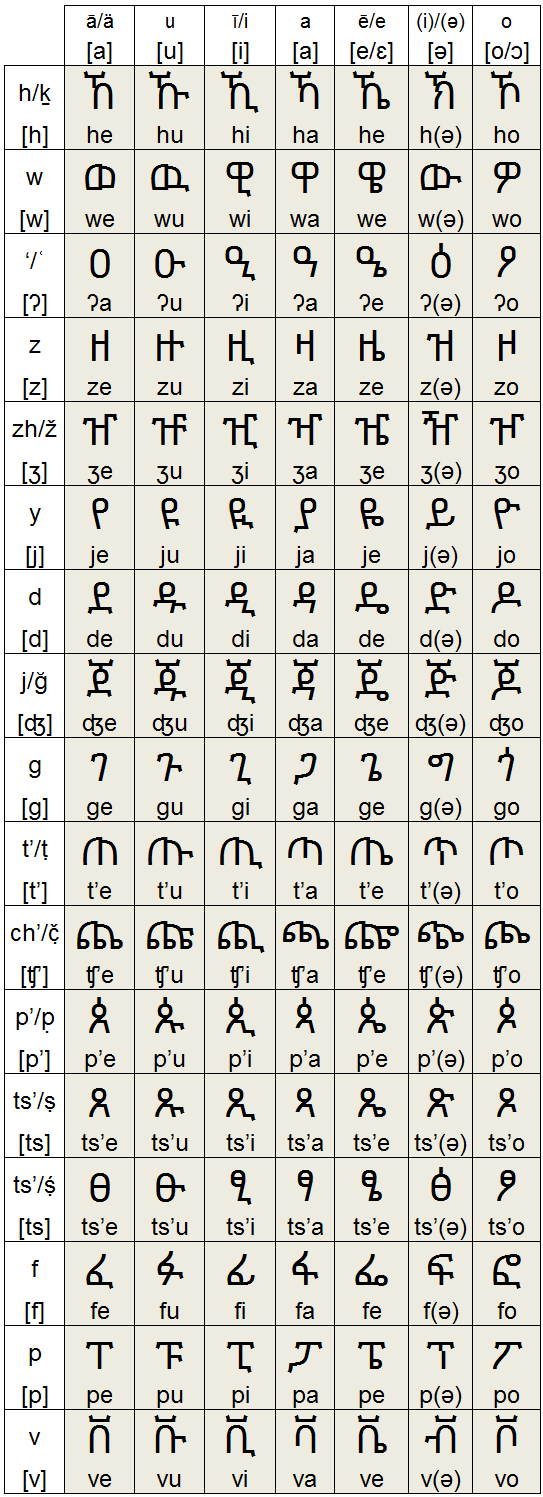ETHIOPIA
Ethiopia is also the origin of the coffee bean. Ethiopia is a land of natural contrasts; with its vast fertile West, jungles, and numerous rivers, the world's hottest settlement of Dallol in its north, Africa's largest continuous mountain ranges and the largest cave in Africa at Sof Omar. Ethiopia's ancient Ge'ez script, also known as Ethiopic, is one of the oldest alphabets still in use in the world. It shares many similarities with the Armenian alphabet. The Ethiopian calendar is seven years and about three months behind the Gregorian calendar.
Short Historical Introduction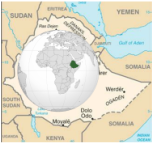
LOCATION AND SIZE.
Source: Nations Encyclopedia Ethiopia is located in the Horn of Africa with a total area of 1,127,127 square kilometers (935,183 square miles), rendering it slightly less than twice the size of Texas. A landlocked country completely surrounded by other states, Ethiopia has a total border length of 5,311 kilometers (3,300 miles). Ethiopia is bordered by Kenya to the south, Somalia to the east, Djibouti and Eritrea to the northeast, and Sudan to the west. The capital of Ethiopia, Addis Ababa, is located in the heart of the country. Read more: Nations Encyclopedia - Ethiopia Fasil-GhebbiSource: CNN| By Oliver Robinson, for CNN 20 July, 2013
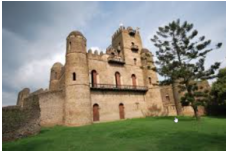
Fasil-Ghebbi is the remains of a fortress-city within Gondar, Ethiopia. It was founded in the 17th and 18th centuries by Emperor Fasilides (Fasil) and was the home of Ethiopia's emperors. Its unique architecture shows diverse influences including Nubian, Arab, and Baroque styles. The site was inscribed as a UNESCO World Heritage Site in 1979. Ghebbi is an Amharic word for a compound or enclosure. The complex of buildings includes Fasilides' castle, Iyasu I's palace, Dawit III's Hall, a banqueting hall, stables, Empress Mentewab's castle, a chancellery, library and three churches: Asasame Qeddus Mikael, Elfin Giyorgis and Gemjabet Mariyam. British and Dutch colonial uildings attract the most architectural attention in east Africa, but Ethiopia again stands out as the only country on the continent with its own fairy tale castles.Aside from a few eye-catching art deco buildings left over from the Italian occupation, the castles of Fasilides, Iyasu and Mentwab, in the former imperial capital of Gondar, are the structures that stay in the mind. Gondar is a five-hour drive southwest of Aksum. A good stopping point is Debark, with its mountain vistas. Church of Saint Mary of ZionSource: JEWIS Virtual Library
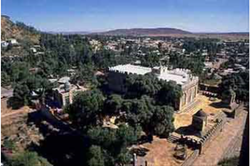
One of the most fascinating possibilities is advanced by Ethiopian Christians who claim that they have the Ark today. In Axum, Ethiopia, it is widely believed that the Ark is currently being held in the Church of Saint Mary of Zion, guarded by a monk known as the "Keeper of the Ark," who claims to have it in his possesion. According to the Axum Christian community, they acquired the Ark during the reign of Solomon, when his son Menelik, whose mother was the Queen of Sheba, stole the Ark after a visit to Jerusalem. While in the not-so-distant past the "Ark" has been brought out for Christian holidays, its keeper has not done so for several years due to the tumultuous political situation in the country. The claim has thus been impossible to verify, for no one but the monk is allowed into the tent. The Axum Obelisk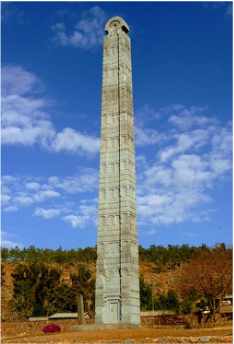
The Axum Obelisk is a 1,700-years-old, 24-meters-tall (79-foot) granite obelisk, weighing 160 tones, in the city of Axum in Ethiopia. It is ornamented with two false doors at the base and features decorations resembling windows on all sides. The obelisk ends in a semi-circular top part, which used to be enclosed by metal frames. Axum was the center of the marine trading power known as the Aksumite Kingdom, which predated the earliest mentions in Roman era writings. Around 356, its ruler was converted to Christianity by Frumentius. Later, under the reign of Kaleb, Axum was a quasi-ally of Byzantium against the Persian Empire. It is believed it began a long slow decline after the 7th century due partly to the Persians and finally the Arabs contesting old Red sea trade routes. Eventually Aksum was cut off from its principal markets in Alexandria, Byzantium and Southern Europe and its trade share was captured by Arab traders of the era. The Kingdom of Aksum was finally destroyed by Gudit and eventually some of the people of Aksum were forced south and their civilization declined. As the kingdom's power declined so did the influence of the city, which is believed to have lost population in the decline, similar to Rome and other cities thrust away from the flow of world events. The last known (nominal) king to reign was crowned in about the 10th century, but the kingdom's influence and power ended long before that. References: - Ancient-wisdom - Around the world in 80 treasures Lalibela's monolithic churchesSource: CNN| By Oliver Robinson, for CNN 20 July, 2013
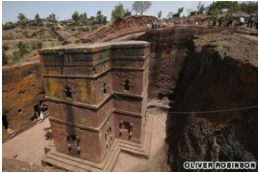
Ethiopia sags under the weight of its cultural treasures, such as those at the UNESCO World Heritage site Lalibela. In the late 12th century, Gebre Mesqel Lalibela had 13 churches -- Ethiopia is one of the oldest Christian nations -- carved out of solid rock.
His achievement (meaning that of his stonemasons and slaves) is still incredibly impressive nine centuries on. Lalibela -- the first major point of interest on the Northern Circuit -- is a 10-hour journey from Addis Ababa. Head north up Route 1, passing through Debre Birhan, Kombolcha and Dessie. At Weldiya, leave the highway and follow the road west to Gashena. At Gashena, take the road north to Lalibela. Unique Elements of Ethiopia (ኢትዮጵያ)
This is not eaten with utensils, but instead one uses the injera to scoop up the entrées and side dishes. Almost universally in Ethiopia, it is common to eat from the same dish in the center of the table with a group of people. It is also a common custom to feed others in your group with your own hands – a tradition referred to as "gursha."Traditional Ethiopian cuisine employs no pork or shellfish of any kind, as they are forbidden in the Islamic, Jewish, and Ethiopian Orthodox Christian faiths.
CalendarThe Ethiopian calendar, also known as the Ge'ez calendar, is based on the older Alexandrian or Coptic calendar, which in turn derives from the Egyptian calendar. Like the Coptic calendar, the Ethiopian calendar has twelve months of exactly 30 days each plus five or six epagomenal days, which comprise a thirteenth month. The Ethiopian months begin on the same days as those of the Coptic calendar, but their names are in Ge'ez. Ethiopia has its own ancient calendar. The Ethiopian Calendar has more in common with the Coptic Egyptian Calendar. The Ethiopic and Coptic calendars have 13 months, 12 of 30 days each and an intercalary month at the end of the year of 5 or 6 days depending whether the year is a leap year or not. The Ethiopian calendar is much more similar to the Egyptian Coptic calendar having a year of 13 months, 365 days and 366 days in a leap year (every fourth year) and it is much influenced by the Ethiopian Orthodox Tewahedo Church, which follows its ancient calendar rules and beliefs. The year starts on 11 September in the calendar or on the 12th in (Gregorian) Leap Years. The Coptic Leap Year follows the same rules as the Gregorian so that the extra month always has 6 days in a Gregorian Leap Year. The Ethiopic calendar differs from both the Coptic and the Julian calendars. The difference between the Ethiopic and Coptic is 276 years. In spite of this, the Ethiopic Calendar is closely associated with the rules and the different calculations influenced by the Coptic Church and the Ethiopian Orthodox Tewahido Church. Based upon the ancient Coptic Calendar, the Ethiopian Calendar is seven to eight years behind the Gregorian calendar, owing to alternate calculations in determining the date of the annunciation of the birth of Jesus. TimeTime in Ethiopia is counted differently from in many Western countries. The Ethiopian day is reckoned as beginning at 6 AM as opposed to 12 AM, concurrently with sunrise throughout the year. To convert between the Ethiopian clock and Western clocks, one must add (or subtract) 6 hours to the Western time. For example, 2 AM local Addis Ababa time is called "8 at night" in Ethiopia, while 8 PM is called "2 in the evening". Ethiopian AlphabetsGe'ez (ግዕዝ Gəʿəz), (also known as Ethiopic) is a script used as an abugida (syllable alphabet) for several languages of Ethiopia and Eritrea. It originated as an abjad (consonant-only alphabet) and was first used to write Ge'ez, now the liturgical language of the Ethiopian Orthodox Tewahedo Church and the Eritrean Orthodox Tewahedo Church. In Amharic and Tigrinya, the script is often called fidäl (ፊደል), meaning "script" or "alphabet". The Ge'ez script has been adapted to write other, mostly Semitic, languages, particularly Amharic in Ethiopia, and Tigrinya in both Eritrea and Ethiopia. It is also used for Sebatbeit, Me'en, and most other languages of Ethiopia. In Eritrea it is used for Tigre, and it has traditionally been used for Blin, a Cushitic language. Tigre, spoken in western and northern Eritrea, is considered to resemble Ge'ez more than do the other derivative languages. Some other languages in the Horn of Africa, such as Oromo, used to be written using Ge'ez, but have migrated to Latin-based orthographies. For the representation of sounds, this article uses a system that is common (though not universal) among linguists who work on Ethiopian Semitic languages. This differs somewhat from the conventions of the International Phonetic Alphabet. See the articles on the individual languages for information on the pronunciation. Amharic is written with a version of the Ge'ez script known as ፊደል (Fidel). Sample Amharic text: ይህ፡ የአማርኛ፡ አረፍተነገር፡ ነው። Translation: “This is an Amharic sentence.” ClimateThe Ethiopian Highlands cover most of the country and have a climate which is generally considerably cooler than other regions at similar proximity to the Equator. Most of the country's major cities are located at elevations of around 2,000–2,500 m (6,562–8,202 ft) above sea level, including historic capitals such as Gondar and Axum. The modern capital Addis Ababa is situated on the foothills of Mount Entoto, at an elevation of around 2,400 m (7,874 ft). It experiences a mild climate year round. With fairly uniform temperatures, the seasons in Addis Ababa are largely defined by rainfall, with a dry season from October–February, a light rainy season from March–May, and a heavy rainy season from June–September. There are on average 7 hours of sunshine per day, meaning it is sunny for around 60% of the available time. The dry season is the sunniest time of the year, though even at the height of the rainy season in July and August there are still usually several hours per day of bright sunshine. The average annual temperature in Addis Ababa is 16 °C (60.8 °F) Most major cities and tourist sites in Ethiopia lie at a similar elevation to Addis Ababa and have a comparable climate. In less elevated regions and shrub lands in the east of the country, the climate can be significantly hotter and drier. Ethiopia has several high mountains, the highest of which is Ras Dashan at 15,158 ft (4,620 m). The Blue Nile River, or Abbai, rises in the northwest and flows in a great semicircle before entering the Sudan. Its chief reservoir, Lake Tana, lies in the northwest part of Ethiopia. MusicThe music of Ethiopia is extremely diverse, with each of the country's 80 ethnic groups being associated with unique sounds. Ethiopian music uses a distinct modal system that is pentatonic, with characteristically long intervals between some notes. As with many other aspects of Ethiopian culture and tradition, tastes in music and lyrics are strongly linked with those in neighboring Eritrea, Somalia, Djibouti and Sudan. Traditionally, lyricism in Ethiopian song writing is strongly associated with views of patriotism or national pride, romance, friendship and most uniquely memoire known as "Tizita." Sample musics: Amharic, Tigrigna, Oromifa, Guragigna, Traditional mix, Instrumental, (Download the Amharic Alphabets “Fidel” spreadsheet) Sample Amharic text: ይህ፡ የአማርኛ፡ አረፍተነገር፡ ነው። Translation: “This is an Amharic sentence.” Online Amharic Dictionaries: |
|



